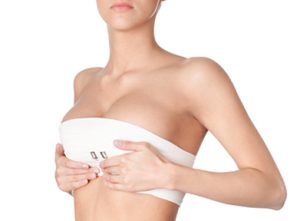
What Exactly Is Breast Implant Rippling?
Rippling occurs when the implant shell or filler material creates visible ridges or waves under the skin. It is most noticeable along the sides of the breast, the lower pole, or the cleavage area. In some cases the rippling can be felt more easily than it can be seen. While mild rippling can occur in any patient, more pronounced rippling is typically the result of implant type, placement, or individual anatomical factors.
Common Causes of Implant Rippling
Breast implant rippling can occur for several reasons, and understanding these factors helps surgeons determine the best solution.
Insufficient Natural Breast Tissue
Patients with thin or minimal breast tissue are more prone to rippling because there is less natural coverage over the implant. When tissue is thin, the edges or folds of the implant become more visible.
Implant Placement Above the Muscle
When implants are placed over the chest muscle, there is less soft tissue coverage. Subglandular placement can create a more natural look in some patients, but it increases the risk of rippling, especially in individuals with lean frames.
Saline Implants
Saline implants are more likely to ripple than silicone implants because the saline solution does not mimic natural breast tissue as closely. Saline implants may also develop slight underfilling, which exaggerates wrinkles in the implant shell.
Aging and Weight Changes
Over time, natural breast tissue thins due to aging, hormonal changes, or weight loss. This thinning can reveal rippling that wasn’t noticeable immediately after surgery.
Implant Size or Profile
Larger implants or implants with high profiles can stretch tissues, making rippling more visible. Similarly, certain implant shapes or textures may be more prone to folding under pressure.
How Surgeons Correct Breast Implant Rippling
The best approach to correcting rippling depends on its cause, severity, and the patient’s anatomy. Dr. Kim offers multiple solutions to help patients achieve smoother, more natural contours.
Switching to Silicone Implants
Modern silicone implants have a cohesive gel that closely mimics the feel of natural breast tissue. They offer improved softness and significantly reduce visible rippling. Many patients who experience rippling with saline implants achieve excellent results after switching to silicone.
Changing Implant Placement
Moving the implant beneath the chest muscle (submuscular placement) provides an additional layer of coverage, reducing the appearance of rippling. This approach is especially effective for patients with minimal native tissue.
Adding Fat Grafting for Extra Coverage
Fat transfer to the breast is a highly effective method for softening rippling. During the procedure, fat is harvested from another area of the body, purified, and injected strategically around the implant to improve contour and camouflage visible edges.
Selecting a Different Implant Size or Profile
Adjusting the implant size or choosing a different profile can reduce stress on tissues and improve the overall appearance. A thorough consultation helps determine which implant style will best match your anatomy and goals.
Correcting Capsular Issues
In rare cases, rippling may be related to capsular contracture or a loosened implant pocket. Revision surgery can address these issues by reshaping the pocket or replacing the implant.
How to Reduce the Risk of Rippling From the Start
Choosing the right surgeon is one of the most effective ways to minimize the risk of rippling. Dr. Kim uses advanced planning, precise measurements, and modern implant options to ensure his patients receive results that fit their anatomy and aesthetic preferences. Patients can also reduce rippling risk by selecting cohesive silicone implants, opting for submuscular placement when appropriate, and maintaining a stable weight after surgery.
When to Consider a Revision Consultation
If you notice visible wrinkles along the sides or lower portion of your breasts, feel ripples when you touch the skin, or are unhappy with the look of your implants, a consultation can help determine the best correction approach. Rippling can be successfully treated in most patients, and revision surgery often leads to significant improvements in shape, symmetry, and confidence.
Expert Breast Implant Revision With Dr. David Kim
Dr. David Kim is an experienced cosmetic surgeon known for delivering natural, lasting results. Whether you are seeking your first breast augmentation or need revision surgery to correct rippling, he provides personalized treatment plans with a focus on safety, proportion, and aesthetics.
If you are experiencing breast implant rippling or would like an expert evaluation, Dr. Kim can help you explore the best surgical options to achieve a smoother, more refined look.
Schedule a Consultation with Beverly Hills California Plastic Surgeon Dr. Kim
For more information on the surgical and non-surgical procedures and treatments by Cosmetic Plastic Surgeons Dr. David Kim and Dr. Eugene Kim. Click here to contact us today.
Also visit beverlyhillsplasticsurgery.com
Serving Beverly Hills, Los Angeles, West Hollywood, Orange County, Southern California and surrounding areas.
